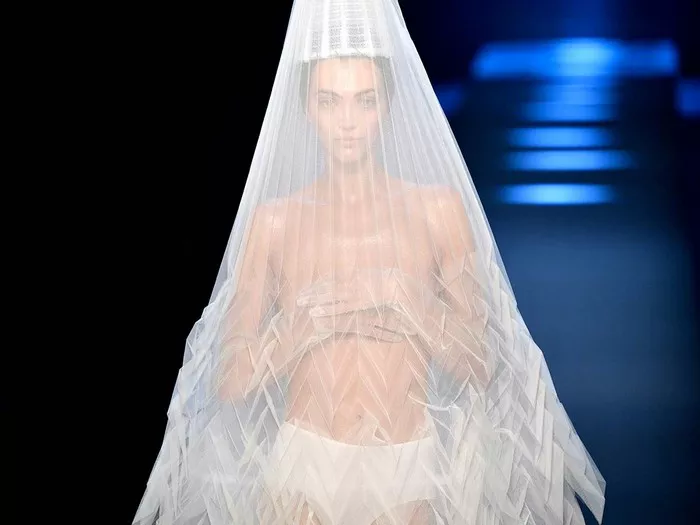Since 1910, Women’s Wear Daily (WWD) has been chronicling the evolution of bridal fashion, documenting everything from the details of the bride’s dress to the latest trends, guest arrivals, and after-parties. The fashion world has witnessed significant shifts in wedding dress styles over the decades, with designers continually challenging traditions while embracing timeless elegance. From the early days of the hobble skirt to modern bridal pantsuits and everything in between, bridal fashion has evolved into a diverse celebration of individuality and style.
The Early Days: Timeless Traditions and Classic Silhouettes
One of the first entries in WWD’s bridal archives revolves around the hobble skirt, a silhouette popularized by French couturier Paul Poiret. This tight-fitting, ankle-length skirt made it nearly impossible for women to walk freely, but it became a dramatic statement of style. While the hobble skirt is now a thing of the past, the concept of a bride’s dress as an iconic fashion moment has endured.
In the early 20th century, bridal gowns were primarily influenced by tradition, with the iconic white wedding dress becoming the standard after Queen Victoria’s marriage to Prince Albert in 1840. For many years, wedding dresses remained heavily structured and formal, focusing on modesty, simplicity, and elegance. These dresses were often characterized by long trains, delicate lace, and full skirts—creating an aura of regality and grandeur.
1960s-1980s: Pioneering Designers Break Boundaries
The 1960s through the 1980s saw bridal fashion become more experimental, with designers incorporating bold elements into their collections. In 1965, Yves Saint Laurent closed his runway season with a groundbreaking knit bridal gown inspired by Russian matryoshka nesting dolls, challenging the norms with its unconventional silhouette. This dress, along with his couture bride pantsuit in 1970, marked a new chapter in bridal fashion, showcasing that brides didn’t have to conform to traditional standards.
In 1987, American designer Willi Smith made a daring choice for his bride and groom, incorporating faux fur into the wedding look—a nod to both environmental consciousness and fashion-forward thinking. These developments signaled a shift toward a more innovative and individualistic approach to bridal wear.
Late 1980s-1990s: The Rise of Vera Wang and John Galliano
The late 1980s and early 1990s marked a turning point in bridal fashion, with designers like Vera Wang and John Galliano pushing boundaries and revolutionizing the category.
Vera Wang, who launched her bridal line in 1989, changed the wedding dress landscape forever. Wang introduced bold, modern designs that departed from the traditional bridal gown’s rigidity. Her creations often featured more relaxed silhouettes, incorporating luxurious fabrics and intricate details, making bridal fashion more accessible and stylish.
In 1999, John Galliano brought something truly groundbreaking to his spring couture collection for Christian Dior: a same-sex bride couple walked down the runway. Galliano’s inclusion of diverse representations of love and marriage in his bridal designs mirrored the broader societal shifts toward inclusivity. This moment marked a significant move towards gender inclusivity and non-traditional bridal representations in the fashion world.
Today: Contemporary Brides Redefining Tradition
Today’s bridal designers continue to play with tradition, offering an array of choices that combine timeless elegance with modern, unconventional designs. Bridal fashion is no longer confined to a single silhouette or aesthetic. Designers have embraced innovative silhouettes, experimental fabrics, and non-traditional color palettes, allowing brides to fully express their personality and style on their special day.
From bridal pantsuits to structured jumpsuits, bold prints, and architectural designs, the modern bride is free to break away from convention. Designers like Oscar de la Renta, Marchesa, and Reem Acra still honor the classic elements of bridal wear, such as lace and silk. However, they add contemporary twists, such as asymmetrical necklines, capes, and metallic fabrics, that challenge expectations.
One of the most significant shifts in recent years has been the embracing of color. Bridal collections have expanded beyond the traditional white or ivory gown, incorporating hues like blush pink, champagne, and even bold reds and blues for brides seeking a more personalized approach.
Iconic Moments: From Yves Saint Laurent to Today
One standout example of bridal fashion evolution is Yves Saint Laurent’s spring 1965 wedding dress, which was inspired by Russian nesting dolls. The dress became a symbol of avant-garde bridal wear, and it was recreated in 2002 during the YSL haute couture retrospective at the Pompidou Centre in Paris. This dress highlighted the timeless influence of YSL’s bridal designs and remains an iconic moment in the history of wedding fashion.
As bridal fashion continues to evolve, it’s clear that designers are committed to creating a space where brides can express their individuality while still honoring the tradition and romance of their wedding day. The bold and unconventional designs seen today show that the future of bridal fashion is as exciting as ever, with endless possibilities for what a wedding dress can be.
Conclusion: A Fashion Moment Like No Other
From the classic elegance of early 20th-century bridal wear to the avant-garde creations of today’s top designers, wedding dresses have come a long way. Fashion shows have always been the stage for this evolution, with designers using the bridal runway to push boundaries and challenge norms. Whether adhering to tradition or embracing bold new concepts, wedding dresses continue to be one of the most powerful symbols of style, individuality, and love. The evolution of wedding dresses at fashion shows has ensured that the wedding gown remains a timeless yet dynamic fashion statement for brides of all kinds.

